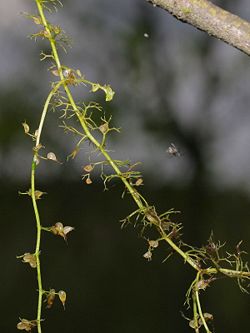| Utricularia minor | |
|---|---|
 | |
| Scientific classification | |
| Kingdom: | Plantae |
| Clade: | Tracheophytes |
| Clade: | Angiosperms |
| Clade: | Eudicots |
| Clade: | Asterids |
| Order: | Lamiales |
| Family: | Lentibulariaceae |
| Genus: | Utricularia |
| Subgenus: | Utricularia subg. Utricularia |
| Section: | Utricularia sect. Utricularia |
| Species: | U. minor |
| Binomial name | |
| Utricularia minor | |
| Synonyms [2] | |
List
| |
Utricularia minor, the lesser bladderwort, [3] is a small species of perennial carnivorous plant in the family Lentibulariaceae. It is usually found affixed to the substrate but it can also survive suspended in a body of water. U. minor is a circumboreal species and is found in North America, Asia, and Europe. [4]
